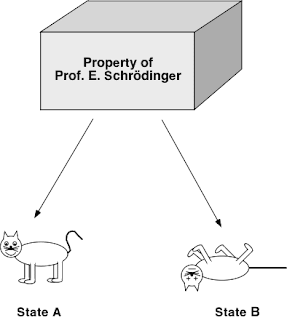A cop pulls a car over and asks to see a driver's license. He looks at it and asks "Dr. Heisenberg, do you know how fast you were going?" Dr. Heisenberg answers, "I have no idea. But I know precisely where I was."
Later the cop pulls a second car over, and after looking at the driver's license says "Dr. Schroedinger, I noticed you were driving erratically. Do you mind if I search your car?" Dr. Schroedinger gives him permission. After searching, he comes back to the driver's window. "Dr. Schroedinger, are you aware that there's a dead cat in your trunk?" Dr. Schroedinger says, "Well, there is now."
Friday, February 27, 2009
An Old Joke
(related to yesterday's post)
Wednesday, February 25, 2009
From a Recent Letter That I Sent
 Dear X___,
Dear X___,I forget what we were talking about, but some time ago I mentioned that an observed object differs in substance from that same object unobserved. The idea is based upon Werner Heisenberg prinicples, the Copenhagen Interpretation ("In effect, the act of measurement causes the calculated set of probabilities to "collapse" to the value defined by the measurement.") and is illustrated by Schroedinger's Cat.
I think that you expressed interest in this concept and asked me, at the time, to send you something about this. Here, belatedly, is that information.
"The quantum reality problem arises primarily because quantum theory describes the world in two ways, not one. Quantum theory represents an object differently depending on whether it is being observed or not being observed. Every physicists without exception uses this twofold quantum description in his or her own work, but physicists hold many divergent opinions about "what is actually going on" during these two stages in an object's existence: being observed and not-being-observed.
 Whenever an object--bulldog, baseball, or baryon--is not under observation, quantum physicists represent that object as a "wave of probability", called the object's "wave function". instead of definite values for attributes such as position, velocity and spin, each of the object's attributes takes on--in the mathematics at least--a wide range of possible values, values that oscillate in a wavelike manner at a variety of different frequencies. This way of treating unobserved objects is one of quantum theory's most peculiar features. Physicists treat an unobserved object not as a real thing but as a probability wave, not as an actiual happening but only as a bundle of vibratory possibilities.
Whenever an object--bulldog, baseball, or baryon--is not under observation, quantum physicists represent that object as a "wave of probability", called the object's "wave function". instead of definite values for attributes such as position, velocity and spin, each of the object's attributes takes on--in the mathematics at least--a wide range of possible values, values that oscillate in a wavelike manner at a variety of different frequencies. This way of treating unobserved objects is one of quantum theory's most peculiar features. Physicists treat an unobserved object not as a real thing but as a probability wave, not as an actiual happening but only as a bundle of vibratory possibilities.On the other hand, when an object is observed, it always manifests at one particular place, with one particular spin and velocity, instead of a smeared-out range of physical properties. During the act of measurement, the mathematical description abruptly shifts--from a spread-out range of possible attributes (unmeasured object) to single-valued actual attributes (measured object). This sudden measurement-induced switch of descriptions is called "the collapse of the wave function", or simply "the quantum jump". What actually happens during a quantum jump is the biggest mystery in quantum physics. Whether this drastic shift in the mathematical description corresponds to an actual dislocation in the real world or is a purely mathematical quirk continues to be a matter of deep controversy in the physics community." - http://quantumtantra.com/werner.html
Of course, some would say, that nothing exists in an unobserved state. That is, there is always something that fulfills the role of observer (the box observes the cat, the cat observes itself) and, thus, if there is such a thing as wave function collapse, it has always already occurred before our own observation is added.
Wikipedia is a decent source for summaries of the fundamental concepts.
Peace,
Dennis

Tuesday, February 24, 2009
Sunday, February 22, 2009
Intelligence is easier, and more simple to abide by, than real emotion or living life in the actual rawness of truth. Truth is never reasoned or figured out; it only emerges when one remains vulnerable long enough to discover, accept and offer to others, one's own faults and shortcomings. It is the test beyond tests that most fail to be able to endure. Rather, almost as if by default, we shut down, close others out and guard ourselves against challenges that we cannot control. We prefer the truth that comes packaged in our own boxes, wrapped by our own selves.
Thursday, February 19, 2009
Monday, February 16, 2009
Orange
Thursday, February 12, 2009
Wednesday, February 11, 2009
Subscribe to:
Comments (Atom)







